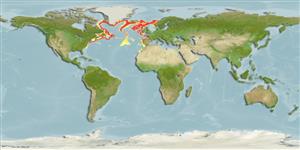Classificação / Names
Common names from other countries
Referência principal
Tamanho / Peso / Idade
Max length : 110 cm TL macho/indeterminado; (Ref. 35388); Peso máx. publicado: 1.7 kg (Ref. 40637); Idade máx. registada: 54 anos (Ref. 41452)
Length at first maturity
Lm 52.7, range 60 - ? cm
Ambiente
; marinhas batipelágico; intervalo de profundidade 180 - 2600 m (Ref. 58426), usually 400 - 1200 m (Ref. 1371)
Clima / Intervalo
Deep-water, preferred 8°C (Ref. 107945); 66°N - 20°N, 77°W - 12°E
Distribuição
North Atlantic: from about 37°N to Baffin Island and Greenland in the western Atlantic, and off Iceland and Norway south to North Africa in the eastern Atlantic. Reported to occur from the tongue of the Ocean east of Andros Islands (about 24°N, 77°W) in the Bahamas.
Países | Áreas FAO | Ecossistemas | Ocorrências | Introduções
Descrição breve
Espinhos dorsais (total): 2; Espinhos anais 0. Head broad, rather soft; snout broad, rounded, with a large blunt tubercular scute at its tip; chin with small barbel. Scales relatively adherent; spinules dense on body scales, long, thin and recurved, narrowly lanceolate, with longitudinal anterior concavity. Pyloric caeca 29 to 31, long and slender. Color medium brown to grayish; orbits, oral and branchial cavities, and fins blackish to brownish gray.
Categoria na Lista Vermelha da IUCN (Ref. 115185)
Ameaça para o homem
Harmless
Utilização humana
Pescarias: espécies comerciais
Ferramentas
Relatórios especiais
Descarregue XML
Fontes da internet
Estimates of some properties based on models
Phylogenetic diversity index
PD50 = 0.5000 many relatives (e.g. carps) 0.5 - 2.0 few relatives (e.g. lungfishes)
Nível Trófico
3.5 ±0.49 se; Based on food items.
Resiliência
Muito baixo, tempo mínimo de duplicação da população maior que 14 anos (K=0.1; tm=9-11; tmax=54; Fec=10,000)
Vulnerabilidade
High to very high vulnerability (67 of 100)
Categoria de preço
